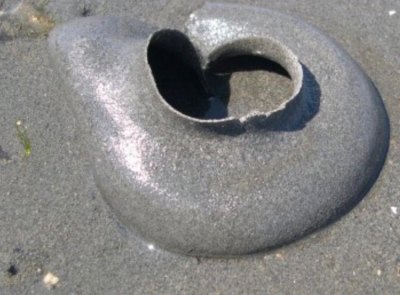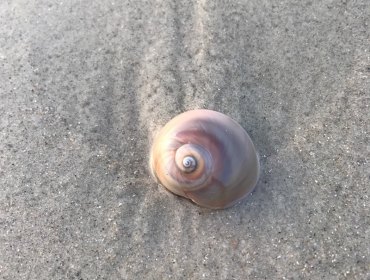I Got Mooned on Ocracoke's Beach!
Some mornings the humidity is so high that my camera lens fogs up and won’t ever seem to clear, so instead of snapping photos of the sunrise, my attention focuses on the surf. You never know what’s going to wash up or what critters and tracks you might see, so every outing can be quite an adventure.
On one of these super-humid morning walks hardly anything was coming up on the beach. Watching the coquinas surface then disappear as the waves went in and out was pretty neat, but as far as beach treasures go there wasn’t a whole lot. Before I explain the wildlife happenings of this specific morning, here’s a quick history of my shelling experiences.
I’ve pretty much given up on searching for sand dollars because I’ve found maybe three whole ones in the seven years I’ve lived here. Finding bits and pieces isn’t very impressive and since I don’t drive on the beach I’ve pretty much eliminated myself from easily accessing the sand dollar hot spots. Thank goodness for Portsmouth, amiright?
Whelks I find all.the.time. Small whelks, fossilized whelks, whelks the size of my foot (size 11, for reference), and even if these shells are broken and busted, the spiral inside the shell is still really pretty. I don’t typically take whelks home anymore because I’ve taken home a lot in previous years and I’m pretty sure that if I go home with another large whelk it too will end up on the railing of our back deck. They do look pretty cool out there, but they’re just more things to remove for hurricane prep so I’m *trying* to limit how many we have. Our dogs can get on shell-chewing-crazes from time to time (because we don’t give them toys or anything for the back yard *heavy sarcasm*) and it kind of makes me sad when I see a gap in the shell line-up and hear the crunch-crunch-crunching of one of my beach treasures in the mouth of one of our beasties.
I also seem to have an eye for finding Scotch Bonnets. These are the state shell of North Carolina and people L.O.V.E. them! I have dozens. Earlier this summer I had so many I was giving them away because there were bags full of them in our spare room. I’d crafted with them, made cute little string light arrangements with them, and used them to support fake flowers in large vases. Of course now that I’ve said all that, what’s going to happen is I won’t find another Scotch Bonnet for the remaining years I live here. Oh, the irony.
But, what I don’t usually find are shells with creatures still in them. I’m strictly talking about ocean beaches in this piece, because how often have you picked up a beautiful shell at Springer’s Point only to realize there’s a crab in there? So on this morning I referenced at the beginning, shelling opportunities were looking bleak at best. But then, I saw a tiny spot reflecting the morning sun’s light! A perfectly intact and swirly moon shell sat on the sand in front of me! I immediately got closer only to see a blobby critter sticking out! Out of sheer curiosity I picked it up and something pretty neat happened: the critter was covering itself with some sort of door! I’d never seen anything like that happen in real life, so I took some photos with my phone and returned it to the sand. Feeling quite excited about seeing this mussel-y creature, I was anxious to look up some information about it. Here’s what I found.
Moon snails, and specifically the one I found, are vicious! The moon shell on the beach that super-humid day is called an Atlantic moon shell, though it’s more commonly known as a Shark eye (Neverita dupilcata –There I go, being all science-y again.) These sea snails are predatory (an animal that naturally preys on others), marine (of, found in, or produced by the sea), gastropod (a mollusk of the large class Gastropoda, such as a snail, slug, or whelk), mollusks (large invertebrates, such as snails, slugs, mussels, and octopus). So, Atlantic moon shells house large snails with no back bone that eat their neighbors and their own kind.
In order to reproduce, female eggs must be fertilized by sperm from male moon snails. Once fertilized, the female uses a mixture of sand and mucus to surround her body. Once this layer is completed, the gelatinous casing is cemented to the sandy surface. She can then lay up to 1,000 eggs. After the eggs are evenly dispersed, the female creates another gelatinous layer of mucus and sand to protect the eggs. She then digs underneath the sand collar to release herself.
After a few weeks the little snails hatch as planktonic larvae. The miniscule creatures eat their own shells for a burst of calcium, then immediately begin moving about the ocean floor. Soon after the snails hatch, their shells begin growing around a central axis, giving the shell its swirly shape. These creatures rely on a calcium-rich diet to grow their shells, often feeding on clams and sometimes their own species. To feed, these animals secrete an acidic substance while simultaneously drilling into the shell with its radula. What’s a radula, you might ask? It’s a toothed appendage, but depending on the species, it’s used to bore, saw, tear, or scrape for food. Moon snails use their radula to bore, and once the hole is complete the snails suck out their meals, often eating up to four clams a day.
As the animals grow their shells grow with them. When the snail eats, it will gradually consume enough calcium to grow its shell. A soft material begins to expand in a spiral pattern out from the axis before it hardens into a shell. Moon snails each have a large “stomach foot” (its foot is also its stomach) which they use to comb the ocean floor in search of food. The animals can grow a shell up to 5.5 inches wide, with a fairly large blobby creature inside. For protection, these snails have a hard shell door to cover the opening of their shell. Even with this hard protection, the snail can easily move in and out of its shell, as I saw firsthand.

Atlantic moon snails can be found up and down the East Coast, into the Gulf of Mexico, and as far south as Honduras. They mostly live just below the low tide line, but have been found at depths of 190 feet. Moon snails can live up to seven years, but can find themselves to be meals for sea stars, oysters, and fish. Once their shells are empty – either by predation or natural death – Hermit crabs will occupy the vacant shells.
People can also consume moon snails, squid, and whelks. You’re to clean sand out from the shells before placing them in a saucepan with some white wine. Cover the saucepan and steam for about 25 minutes. Once cooked, you’re to cool them in cold water before picking the snails out of the shells. Be sure to cut off the stomach before consuming. Cooking instructions courtesy of Edible Cape Cod.




